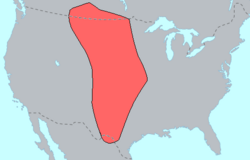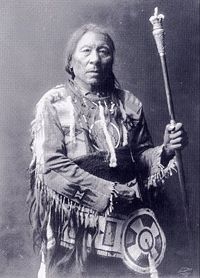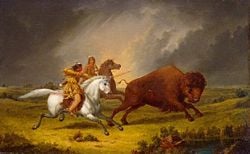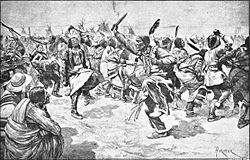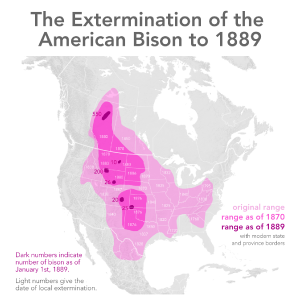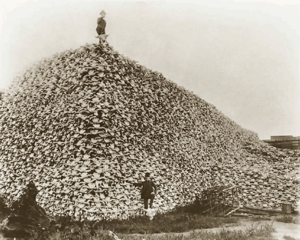Plains Indians
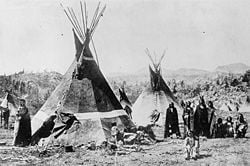
Plains Indians are usually divided into two broad classifications which overlap to some degree.
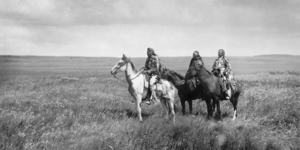
The Plains Indians are the Indigenous peoples who live on the plains and rolling hills of the Great Plains of North America.
Classification

Plains Indians are usually divided into two broad classifications which overlap to some degree.[citation needed] The first group were fully nomadic, following the vast herds of bison. Some tribes occasionally engaged in agriculture—growing tobacco and corn primarily. These included the Blackfoot, Arapaho, Assiniboine, Cheyenne, Comanche, Crow, Gros Ventre, Kiowa, Lakota, Lipan, Plains Apache (or Kiowa Apache), Plains Cree, Sarsi, Sioux, Shoshone, and Tonkawa.
The second group of Plains Indians (sometimes referred to as Prairie Indians) were the semi-sedentary tribes who, in addition to hunting bison, lived in villages and raised crops. These included the Arikara, Hidatsa, Iowa, Kaw (or Kansa), Mandan, Omaha, Osage, Otoe, Pawnee, Ponca, and Wichita.
Culture
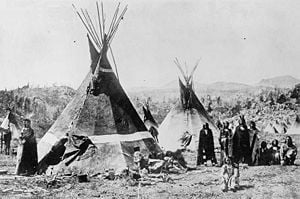
The nomadic tribes survived on hunting, and bison was their main food source. The tribes are described as part of the 'Buffalo Culture' (sometimes called, somewhat misleadingly, the 'Great Plains Culture').[citation needed] American buffalo, or simply buffalo, is the commonly used (but inaccurate) name for the American Bison. These animals were the chief source for items which Indians made from their flesh, hide and bones, such as food, cups, decorations, crafting tools, knives, and clothing. Not a single part of the animal was thrown away.
The tribes kept moving following the seasonal and grazing migration of bison. The Plains Indians created tipis because they were easily disassembled and allowed the nomadic life of following game. When escaped Spanish horses were obtained, the Plains tribes rapidly integrated them into their daily lives, wealth and hunting techniques. They fully adopted a horse culture beginning in the 17th century.[citation needed]
Hunting in the Plains
Although the Indians hunted other animals, such as elk or antelope, bison was the primary game food source. Before horses were introduced, hunting was a more complicated process. The Native Americans would surround the bison, and then try to herd them off cliffs or into places where they could be more easily killed. A commonly used technique was the Piskin method.[citation needed] The tribesmen would build a corral and have people herd the buffalo into it to confine them in a space where they could be killed. The Indians constructed a v-shaped funnel, about a mile long, made of fallen trees, rocks, etc. Sometimes buffalo could be lured into a trap by one of the tribe covering himself with a buffalo skin and imitating the call of the animals.[citation needed]
Prior to their adoption of guns, the Plains Indians hunted with spears, bows and arrows, and various forms of clubs. When horses, brought by the Spanish to America, escaped and started breeding in the wild, the Indians quickly learned how to capture and train them. Their ability to ride horses made hunting (and warfare) much easier. With horses, the Indians had the means and speed to stampede or overtake the bison. The Indians reduced the length of their bows to three feet to accommodate their use on horseback.[citation needed] They continued to use bows and arrows after the introduction of firearms, because guns took too long to reload and were too heavy. In the summer, many tribes gathered for hunting in one place. The main hunting seasons were fall, summer, and spring. In winter harsh snow and mighty blizzards made it almost impossible to kill the bison.
Bison were hunted almost to extinction in the 19th century and were reduced to a few hundred by the mid-1880s. The main reason they were hunted was for their skins, with the rest of the animal left behind to decay on the ground.[1] After the animals rotted, their bones were collected and shipped back east in large quantities.[1]
There were government initiatives at the federal and local level to starve the population of the Plains Indians by killing off their main food source, the bison. The Government promoted bison hunting for various reasons: to allow ranchers to range their cattle without competition from other bovines and to weaken the Indian population and pressure them to remain on reservations.[2] The herds formed the basis of the economies of local Plains tribes of Native Americans for whom the bison were a primary food source. Without bison, the Native Americans would be forced to leave or starve.
The railroad industry also wanted bison herds culled or eliminated. Herds of bison on tracks could damage locomotives when the trains failed to stop in time. Herds often took shelter in the artificial cuts formed by the grade of the track winding though hills and mountains in harsh winter conditions. As a result, bison herds could delay a train for days.
As the great herds began to wane, proposals to protect the bison were discussed. Cody, among others, spoke in favor of protecting the bison because he saw that the pressure on the species was too great. But these were discouraged since it was recognized that the Plains Indians, often at war with the United States, depended on bison for their way of life. In 1874, President Ulysses S. Grant "pocket vetoed" a Federal bill to protect the dwindling bison herds, and in 1875 General Philip Sheridan pleaded to a joint session of Congress to slaughter the herds, to deprive the Indians of their source of food.[3] By 1884, the American bison was close to extinction.
The main reason for the bison's near-demise, much like the actual demise of the passenger pigeon, was commercial hunting. Over years of surviving off the hunt, the metabolism of Plains Indians developed to allow them to survive for longer on less food.[citation needed] This was in response to sometimes long intervals between hunts. In times of plentiful food, Plains Indians took on a lot of extra weight to prepare for times without food. This adaptation saved tribes from starvation, but when Indian reservations/reserves were introduced, the adaptation of carrying weight became a threat to their health.[citation needed] When Natives were confined to reservations, they were less able to hunt, so they took up other means of subsistence.
Great Plains religion
The Plains Indians followed no single religion. Animist religion was an important part of a Great Plains Indians' life, as they believed that all things possessed spirits. Their worship was centered on one main god, in the Sioux language Wakan Tanka (the Great Spirit).[citation needed] The Great Spirit had power over everything that had ever existed, and the Indians believed that by worshiping him they would become stronger.[citation needed] Earth was also quite important, as she was the mother of all spirits. Spirits were worshiped daily.[citation needed] People sometimes prayed alone, while other times there were group gatherings. The most important group ceremony was the Sun Dance,[citation needed] in which participants danced for four days around a sacred object, and some would inflict harm upon themselves on purpose, all while staring at the sun.[citation needed] They believed this self-sacrifice would encourage powerful spirits to support and defend them.
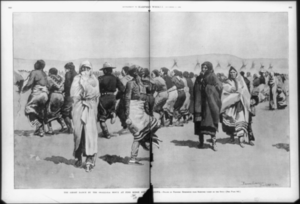
There were also people that were wakan, or blessed, who were also called shaman. To become wakan, your prayers must be answered by the Great Spirit, or you must see a sign from him. Wakan were thought to possess great power. One of their jobs was to heal people, which is why they are also sometimes called "medicine men." The shamans were considered so important that they were the ones who decided when the time was right to hunt.
Plains Indians believed that some objects possessed spiritual or talismanic power. One such item was the medicine bundle, which was a sack carrying items believed by the owner to be important. Items in the sack might include rocks, feathers, and more. Another object of great spiritual power was the shield. The shield was the most prized possession of any warrior, and he decorated it with many paintings and feathers. The spirits of animals drawn on the shield were thought to protect the owner.
Research
The tribes of the Great Plains have been found to be the tallest people in the world during the late 1800s, based on 21st century analysis of data collected by Franz Boas for the World Columbian Exposition.[4] This information is significant to anthropometric historians, who usually equate the height of populations with their overall health and standard of living.
Notes
- ↑ 1.0 1.1 Records, Laban (March 1995). Cherokee Outlet Cowboy: Recollectioons of Laban S. Records. Norman, Oklahoma: University of Oklahoma Press. ISBN 978-0806126944.
- ↑ Moulton, M (1995). Wildlife issues in a changing world, 2nd edition. CRC Press.
- ↑ Bergman, Brian (2004-02-16). Bison Back from Brink of Extinction. Maclean's. Retrieved 2008-03-14.
- ↑ "Standing Tall: Plains Indians Enjoyed Height, Health Advantage", Jeff Grabmeier, Ohio State
ReferencesISBN links support NWE through referral fees
- "American Indian Contributions To Science and Technology", Chris R. Landon, Portland Public Schools, 1993
- "Buffalo and the Plains Indians", South Dakota State Historical Society Education Kit
- Carlson, Paul H. The Plains Indians. College Station: Texas A&M University Press, 1998. ISBN 0-89096-828-4
- Taylor, Colin E. The Plains Indians: A Cultural and Historical View of the North American Plains Tribes of the Pre-Reservation Period. New York: Crescent Books, 1994. ISBN 0517142503
Credits
New World Encyclopedia writers and editors rewrote and completed the Wikipedia article in accordance with New World Encyclopedia standards. This article abides by terms of the Creative Commons CC-by-sa 3.0 License (CC-by-sa), which may be used and disseminated with proper attribution. Credit is due under the terms of this license that can reference both the New World Encyclopedia contributors and the selfless volunteer contributors of the Wikimedia Foundation. To cite this article click here for a list of acceptable citing formats.The history of earlier contributions by wikipedians is accessible to researchers here:
The history of this article since it was imported to New World Encyclopedia:
Note: Some restrictions may apply to use of individual images which are separately licensed.
